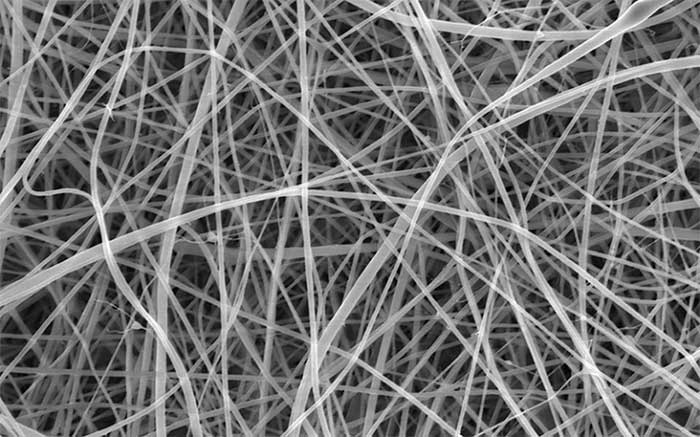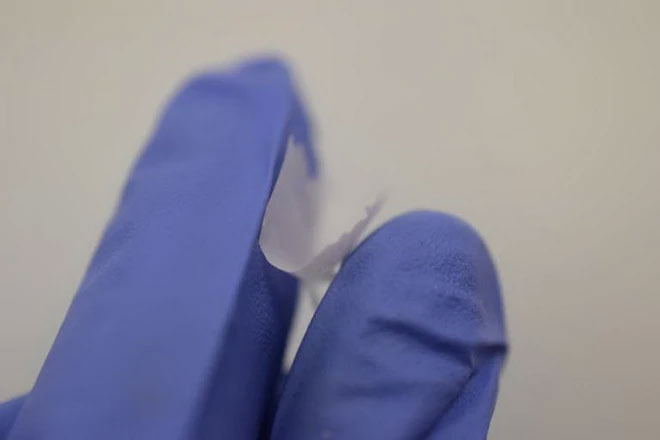Amazed by the super small pasta, only 1/200 the size of a human hair
A team of British scientists have created the world's thinnest spaghetti, about 200 times thinner than a human hair and even narrower than some wavelengths of light.
Scientists at University College London (UCL) have recently created 'nanopasta' - a type of microscopic spaghetti using a technique called electrospinning , in which strands of powder and liquid are pulled through a needle's eye using an electrode.

Nanopasta fibers under a scanning electron microscope. (Source: UCL).
These nanopasta fibers measure 372 nanometers (billionths of a meter) across, 200 times smaller than the average width of a human hair and, according to the UCL report, even narrower than some wavelengths of light.
"Spaghetti is made by pushing a mixture of water and flour through metal holes. We use the same method, but the flour and water mixture is pushed through tiny pinholes using an electrical charge. It's really spaghetti , but much smaller," said Dr Adam Clancy, co-author of the study .
The new Nanopasta is made into a sheet of nanofibers about 2cm in diameter and is visible, but the individual fibers are too thin to be clearly imaged with any type of camera or optical microscope. They can only be observed with a scanning electron microscope (SEM).

A sheet of nanopasta fibres is about 2cm in diameter. (Source: UCL)
The previous record holder for the thinnest pasta in the world was su filindeu , meaning 'God's thread' , created by a Sardinian craftsman. These 'God's threads' were an incredible 400 microns wide, but they were still 1,000 times thicker than the nanopasta created by British scientists.
The team said they did not intend to create the nanopasta for eating, as it would cook 'in less than a second.' Rather, it was a useful experiment to create environmentally friendly nanofibers for use in healthcare.
'Nanofibres, such as those made from starch, have potential for use in wound dressings because they are so porous,' said Professor Gareth Williams, co-author of the study. 'Nanofibres are also being investigated for use as scaffolds for tissue regeneration, as they mimic the extracellular matrix – a network of proteins and other molecules that cells build to support themselves.'
Nanofibers are typically made by extracting starch from plant cells and refining it, but the process is complex and requires a lot of energy and water, according to the UCL team.
The UCL scientists' method of creating nanofibers directly from starch-rich ingredients such as wheat flour, the basic ingredient for making pasta, would be more environmentally friendly.
The researchers used wheat flour and formic acid to make nanopasta, instead of water, because formic acid breaks down the giant spirals that make up starch (cooking has a similar effect to formic acid, breaking down starch to make pasta easier to digest).
The team also had to carefully warm the mixture for several hours before slowly cooling it again to ensure it had the right consistency.
'Starch is a promising material to use because it is abundant and renewable - it is the second largest source of biomass on Earth, after cellulose - and it is biodegradable, meaning it can break down in the body,' said Dr Clancy .
The research on nanopasta was published in the journal Nanoscale Advances.
- Surprise with the traditional way of eating pasta
- How small is the human being in the universe?
- Plastic straws replaced with pasta in Italy
- Aircraft 'spy' ... pocketed
- Small size snacks that help fight fat
- Give back 'blue' for hair
- On the human body has many holes?
- Science proves: The size of the
- 4 super volcanoes threaten humanity
- Golden hair dyeing technology
- Why do people have to cut their hair and not other animals?
- Discovered the gene that indicated curly hair
 'Fine laughs' - Scary and painful torture in ancient times
'Fine laughs' - Scary and painful torture in ancient times The sequence of numbers 142857 of the Egyptian pyramids is known as the strangest number in the world - Why?
The sequence of numbers 142857 of the Egyptian pyramids is known as the strangest number in the world - Why? History of the iron
History of the iron What is alum?
What is alum? A carcinogen that was once banned in Japan and the United States, many people still come into contact with it every day without knowing it.
A carcinogen that was once banned in Japan and the United States, many people still come into contact with it every day without knowing it.  Mystery of the massacre in the cave more than 1,000 years ago
Mystery of the massacre in the cave more than 1,000 years ago  Is the blue whale's heart really the size of a car?
Is the blue whale's heart really the size of a car?  1,000m tall 'strange object' emerges off California coast
1,000m tall 'strange object' emerges off California coast  Strange species in Southeast Asia becomes the first marine fish species 'extinct due to humans'
Strange species in Southeast Asia becomes the first marine fish species 'extinct due to humans'  Why is finding a missing submarine in the ocean like 'looking for a needle in a haystack'?
Why is finding a missing submarine in the ocean like 'looking for a needle in a haystack'? 